Made of a phospholipid - Study guides, Class notes & Summaries
Looking for the best study guides, study notes and summaries about Made of a phospholipid? On this page you'll find 1811 study documents about Made of a phospholipid.
Page 3 out of 1.811 results
Sort by
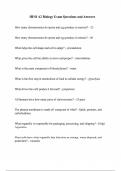
-
HESI A2 Biology Exam Questions and Answers
- Exam (elaborations) • 15 pages • 2024
-
Available in package deal
-
- $12.00
- + learn more
How many chromosomes do sperm and egg produce in meiosis? - 23 How many chromosomes do sperm and egg produce in mitosis? - 46 What helps the cell shape and cell to adapt? - cytoskeleton What gives the cell the ability to move and proper? - microtubules What is the main component of blood plasma? - water What is the first step in metabolism of food to cellular energy? - glycolysis What drives the cell/ pushes it forward? - propulsion All humans have how many pairs of chromosomes? - 23 pair...
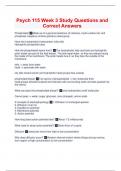
-
Psych 115 Week 3 Study Questions and Correct Answers
- Exam (elaborations) • 12 pages • 2024
-
- $8.99
- + learn more
Phospholipid Made up of a glycerol backbone (3 carbons), hydro-carbon tail, and phosphate (negative) choline (positive) head group Have two hydrophobic hydrocarbon (oily) tails Hydrophilic phosphate head How the phospholipid layers form? The hydrophobic fatty acid tails and hydrophilic polar heads are part of the lipid bilayer. The tails repel water, so they are always facing the inside of the membrane. The polar heads love it, so they face the outside of the membrane. tails -> away from w...

-
ATI RN NUTRITION PRACTICE A Exam with complete solutions
- Exam (elaborations) • 15 pages • 2023
-
Available in package deal
-
- $12.49
- 2x sold
- + learn more
nurse is preparing to bottle feed an infant who has a cleft lip. Which of the following actions should the nurse take to reduce the risk of aspiration? a) burp the infant once at the end of the feeding b) use a bottle that has a two way valve c) place a low-flow rate nipple on the bottle d) squeeze the infants cheeks together while feeding - Answer- D) squeeze the infants cheeks together while feeding * nurse should identify that an infant who has a cleft lip will have difficulty in obta...
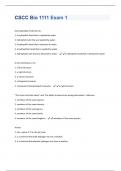
-
CSCC Bio 1111 Exam 1 Questions And Answers Rated A+ New Update Assured Satisfaction
- Exam (elaborations) • 21 pages • 2024
- Available in package deal
-
- $7.99
- + learn more
A phospholipid molecule has 1. a hydrophilic head that is repelled by water. 2. hydrophilic tails that are repelled by water. 3. a hydrophilic head that is attracted to water. 4. a hydrophobic head that is repelled by water. 5. hydrophobic tails that are attracted to water. - a hydrophilic head that is attracted to water. A cell membrane is not 1. a fluid structure. 2. a rigid structure. 3. a mosaic structure. 4. a bilayered structure. 5. composed of phospholipid molecules. - a rigid ...
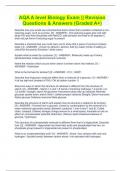
-
AQA A level Biology Exam || Revision Questions & Answers (Graded A+)
- Exam (elaborations) • 57 pages • 2024
-
Available in package deal
-
- $17.99
- + learn more
AQA A level Biology Exam || Revision Questions & Answers (Graded A+) AQA A level Biology Exam || Revision Questions & Answers (Graded A+) Describe how you would use a biochemical test to show that a solution contained a non-reducing sugar, such as sucrose. [3] - ANSWER - ,first reducing sugars test; boil with dilute HCl acid then Neutralise with NaHCǑ, add benedict and heat to 95 degrees C brick red ppt forms if reducing sugar is present Describe a chemical test you could carry out to sh...
![BIOLOGY AQA AS LEVEL 74011 PAPER 1[REAL 100%]](/docpics/5579097/666411e1f2a9c_5579097_121_171.jpeg)
-
BIOLOGY AQA AS LEVEL 74011 PAPER 1[REAL 100%]
- Exam (elaborations) • 5 pages • 2024
-
Available in package deal
-
- $17.99
- + learn more
BIOLOGY AQA AS LEVEL 74011 PAPER 1[REAL 100%] • The human cell then makes a complementary strand to the HIV DNA. The complementary strand is made in the same way as a new complementary strand is made during semi-conservative replication of human DNA. Describe how the complementary strand of HIV DNA is made. - ANS---- there are complementary nucleotides/bases pair - DNA polymerase used - Nucleotides join together (to form new strand)/phosphodiester bonds form; Describe the difference be...
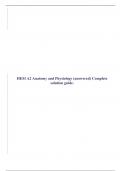
-
HESI A2 Anatomy and Physiology (answered) Complete solution guide.
- Exam (elaborations) • 50 pages • 2023
- Available in package deal
-
- $10.00
- 1x sold
- + learn more
HESI A2 Anatomy and Physiology. 1. Anatomic position 2. Which of the following is a structure found in the upper respiratory? 3. A person who has damage to their ulnar nerve will have decreases sensation in 4. Which bone dose not articulate with any other bone? 5. Which of the following statements best describe endocrine glands? 6. Diet is important because bone are storage places for 7. Which organ is part of both the male reproductive system and the urinary system? 8. Red blood cell production...
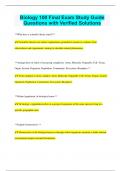
-
Biology 100 Final Exam Study Guide Questions with Verified Solutions
- Exam (elaborations) • 13 pages • 2024
-
- $9.99
- + learn more
Biology 100 Final Exam Study Guide Questions with Verified Solutions **What does a scientific theory entail?** Scientific theories are robust explanations grounded in extensive evidence from observations and experiments, aiming to elucidate natural phenomena. **Arrange these in order of increasing complexity: Atom, Molecule, Organelle, Cell, Tissue, Organ, System, Organism, Population, Community, Ecosystem, Biosphere.** From simplest to most complex: Atom, Molecule, Organelle, Cell,...
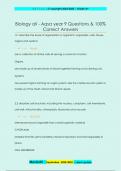
-
Biology all - Aqsa year 9 Questions & 100% Correct Answers
- Exam (elaborations) • 97 pages • 2024
-
- $13.49
- + learn more
2.1 describe the levels of organisation in organisms: organelles, cells, tissues, organs and systems ~~> Tissues are a collection of similar cells all serving a common function. Organs are made up of several kinds of tissues together forming a functioning unit. Systems are several organs forming an organ system. Like the cardiovascular system is made up of the heart, blood and blood vessels. 2.2 describe cell structures, including the nucleus, cytoplasm, cell membrane, cell ...
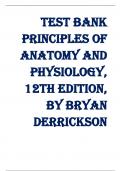
-
Test Bank Principles of Anatomy and Physiology, 12th Edition, by Bryan Derrickson, Gerald Tortora | Complete Guide A+
- Exam (elaborations) • 748 pages • 2023
-
- $17.99
- 1x sold
- + learn more
Test Bank Principles of Anatomy and Physiology, 12th Edition, by Bryan Derrickson, Gerald Tortora Testbank Chapter 1. An Introduction to the Human Body Multiple Choice 1. This is the study of the functions of body structures. a. Anatomy b. Physiology c. Dissection d. Histology e. Immunology Ans: B Difficulty: easy Feedback: 1.1 2. This is defined as a group of cells with similar structure and function. a. Tissue b. Organ c. Molecules d. Compounds e. Organism Ans: A Difficulty: easy Feedback: 1.2...

Do you wonder why so many students wear nice clothes, have money to spare and enjoy tons of free time? Well, they sell on Stuvia! Imagine your study notes being downloaded a dozen times for $15 each. Every. Single. Day. Discover all about earning on Stuvia


